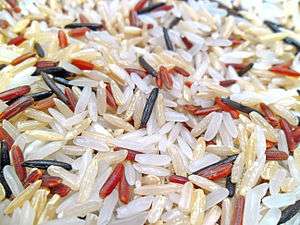Germinated brown rice

Germinated brown rice (GBR; Korean: 발아현미 (hangul), 發芽玄米 (hanja), Bala hyeonmi, Japanese: 発芽玄米 (hatsuga genmai)) is unpolished brown rice that has been allowed to germinate to improve the flavor and texture, and to increase levels of nutrients such as γ-aminobutyric acid (GABA). It has been found that germinated grains in general have nutritional advantages. The rice is used in Japanese and Korean cuisine.[1]
Cooked germinated brown rice is softer and less chewy than plain brown rice—it is more acceptable to children in particular—and has additional nutritional advantages.
Germinated brown rice is brown rice that has been soaked for 4–20 hours in warm 30–40 °C (86–104 °F) water, longer soaking at lower temperature, before cooking, changing water a few times if some smell develops, and rinsing before cooking. This stimulates germination, which activates various enzymes in the rice. By this method, it is possible to obtain a more complete amino acid profile, including GABA.
Although GBR is readily prepared at home, in Japan from 1995 it is sold ready-germinated at a higher price than ordinary rice. In 2004 about 15,000 tonnes were sold, to a value of about ¥15b. The target at that time was eventually to sell 90,000 tonnes of GBR per year, 1% of total rice consumption.
References
- ↑ Ito, Shoichi; Ishikawa, Yukihiro (2004-02-12). "Marketing of Value-Added Rice Products in Japan: Germinated Brown Rice and Rice Bread". Retrieved 6 March 2016.
External links
- Germinated brown rice and rice breadFAO International Year of Rice conference in 2004
- Germinated Brown Rice: Has the U.N. Finally Heard “Nourishing Traditions” Wisdom? March 31, 2010
